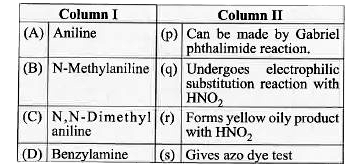Match the entries of column I with appropriate of column II and choose the correct option
out of the four option (a), (b),(c), (d) given at the end of each question

PQRS2134
PQRS4312
PQRS2314
PQRS4132
The correct Answer is:C

Both d-orbitals show axial overlapping in the same
phase . So it is d-d σ bonding .

Both p and d-orbitals show lateral overlapping in
the same phase . so it is p-d π bonding

Both p and d-orbitals show lateral overlapping in
the samse phase . So it is p-d π antibonding

Both the d-orbitals show axial overlap in opposite
phase . So it is d-d σ antibonding .
Topper's Solved these Questions
- CHEMICAL BONDING AND MOLECULAR STRUCTUREBOOK - PRADEEPCHAPTER - CHEMICAL BONDING AND MOLECULAR STRUCTUREEXERCISE - COMPETITION FOCUS JEE (Main and Advanced)/ MEDICAL ENTRANCE SPECIAL (V MATRIX-MATCH TYPE QUESTIONS)
3 Videos
- CHEMICAL BONDING AND MOLECULAR STRUCTUREBOOK - PRADEEPCHAPTER - CHEMICAL BONDING AND MOLECULAR STRUCTUREEXERCISE - COMPETITION FOCUS JEE (Main and Advanced)/ MEDICAL ENTRANCE SPECIAL (VI. INTEGER TYPE QUESTIONS)
15 Videos
- CHEMICAL BONDING AND MOLECULAR STRUCTUREBOOK - PRADEEPCHAPTER - CHEMICAL BONDING AND MOLECULAR STRUCTUREEXERCISE - COMPETITION FOCUS JEE (Main and Advanced)/ MEDICAL ENTRANCE SPECIAL (III. MULTIPLE CHOICE QUESTIONS (Based on the given Passage/Comprehension))
11 Videos
- APPENDIXBOOK - PRADEEPCHAPTER - APPENDIXEXERCISE - MODEL TEST PAPER <br> (Section C )
9 Videos
- CLASSIFICATION OF ELEMENTS AND PERIODICITY IN PROPERTIES BOOK - PRADEEPCHAPTER - CLASSIFICATION OF ELEMENTS AND PERIODICITY IN PROPERTIES EXERCISE - Competition Focus (Jee Main and Advanced / Medical Entrance ) ( Assertion - Reason Type Question ) (Type II)
12 Videos
Similar Questions
Match the entries of column I with appropriate entries of column II and choose the correct option out of the four options (a), (b), ( c ), (d) given at the end of each question.
Column IColumn II(A)Zero order reactions(p)t1/2∝1[A]0(B)First order reactions(q)t100%=[A]0/k(C)Second order reactions(r)Involves at least two reactants(D)Pseudounimolecular reactions(s)[A]=[A]0e−kt
View SolutionMatch the entries of column I with appropriate entries of column II and choose the correct option but of the four options (a), (b), (c ), (d) given at the end of each question.
Column IColumn II(A)Siderite(p)Zinc(B)Chalcocite(q)Aluminium(C)Calamine(r)Copper(D)Bauxine(s)Iron
View Solution
Knowledge Check
Match the entries of column I with appropriate entries of column II and choose the correct option out of the four option (a), (b), (c ), (d) given at the end of each question.
Column IColumn II(Metal ion configuration in strong ligand field)(CFSE, Δ0 value)(A)d4(p)−1.6(B)d5(q)−1.8(C)d6(r)−2.0(D)d7(s)−2.4AA-p, B-s, C-r, D-qBA-q, B-r, C-p, D-sCA-p, B-r, C-s, D-qDA-r, B-s, C-p, D-qMatch the entries of column I with appropriate entries of column II and choose the correct option out of the four option (a), (b), (c), (d) given at the end of each question.
Column IColumn II(A) femto(p) 109(B) yotta(q) 10−15(C) giga(r) 10−18(D) atto(s) 1024AA-q, B-p, C-r, D-sBA-s, B-q, C-p, D-rCA-q, B-s, C-p, D-rDA-r, B-s, C-p, D-qMatch the entries of column I with appropriate entries of column II and choose the correct option out of the four option (a), (b), (c), (d) given at the end of each question.
Column I Column II(A) German silver and gold jewellery(p) Elements(B) Antimony and Bismuth(q) Isomorphs(C) ZnSO4.7H2OandFeSO4.7H2O(r) Polymorphs(D) Zinc blende and Wurtzite(s) Mixtures(E) Graphite and Diamond(t) MetalloidsAA-p, B-r, C-t, D-q, E-sBA-s, B-t, C-q, D-r, E-pCA-q, B-r, C-p, D-t, E-sDA-t, B-s, C-r, D-q, E-p
Match the entries of column I with appropriate entries of column II and choose the correct option out of the four options (a), (b), ( c ), (d) given at the end of each question.
Column I (Reaction)Column II (Order)(A)2 HI→H2+I2(p)0(B)2 NH3→N2+3 H2(q)1(C)2 H2O2→2 H2O+O2(r)112(D)COCl2→CO+Cl2(s)2
View SolutionMatch the entries of column I with appropriate entries of column II and choose the correct option out of the four options (a), (b), ( c ), (d) given at the end of each question.
Column IColumn II(A)Linear plot passing through the origin(p)Conc. [A] vs time t for zero order(B)Linear horizontal plot(q)1/[A] vs time t for 2nd order(C)Linear plot with -ve slope and an intercept(r)t1/2 vs [A]0 for 1st order(D)Linear plot with + ve slope and an intercept(s)t1/2 vs 1/[A]0 for 2nd order
View SolutionMatch the entries of column I with appropriate entries of column II and choose the correct option but of the four options (a), (b), (c ), (d) given at the end of each question.
Column IColumn II(A)Zone refining(p)Titanium(B)Mond's process(q)Lead(C)Liquation(r)Nickel(D)van - Arkel(s)Germanium
View SolutionMatch the entries of column I with appropriate entries of column II and choose the correct option out of the four options (a) , (b) , ( c) ,(d ) given at the end of each questions.
Column I Column II(A)F(p)Maximum ionization enthalpy (B)C1(q) Maximum atomic radius (C)He(r)Maximum electronegativity (D)Cs(s) Maximum negative electron gain enthalpy
View SolutionMatch the entries of column I with appropriate entries of column II and choose the correct option.

View Solution
